CUNY Queens College︎(ARTS241) Design 1
Introduction & Expectations
(There’s a lot of text here, this is mainly for reference & clarity)Syllabus
What is Graphic Design?
![(The Conversion of St. Paul by Elliott Earls, 1994)]()
![(Poster for Ed Fella by Jeff Keedy, 2013)]()
![(Poster for Suzan Pitt lecture by Nicole Killian, 2013)]()
![(Masthead and typography design for Mold magazine by Eric Hu, 2016)]()
![(poster by Ed Fella for San Francisco Type Set, 2001)]()
![(Illuminated manuscript)]()
![(Annual report for The General Fireproofing Company by Chermayeff & Geismar,1969)]()
![(Random-ass Chinese food menu)]()
![(various logos by Paul Rand)]()
![(Book cover for Jurassic Park by Chip Kidd, 1990)]()
![(Sign painting examples by Pierre Tardif)]()
![(still from "Catfish" by Elliott Earls, 2001)]()
![(Ghanian poster for The Heroic Trio, 1993)]()
![(Design for Uffici magazine by Ettore Sottsass and Barbara Radice, 1973)]()
![(Detail from the inscription of the Trajan Column, ~107-113 AD)]()
![(The City and Design, The Wonders of Life on Earth, Isamu Kurita poster by Tadanori Yokoo, 1966)]()
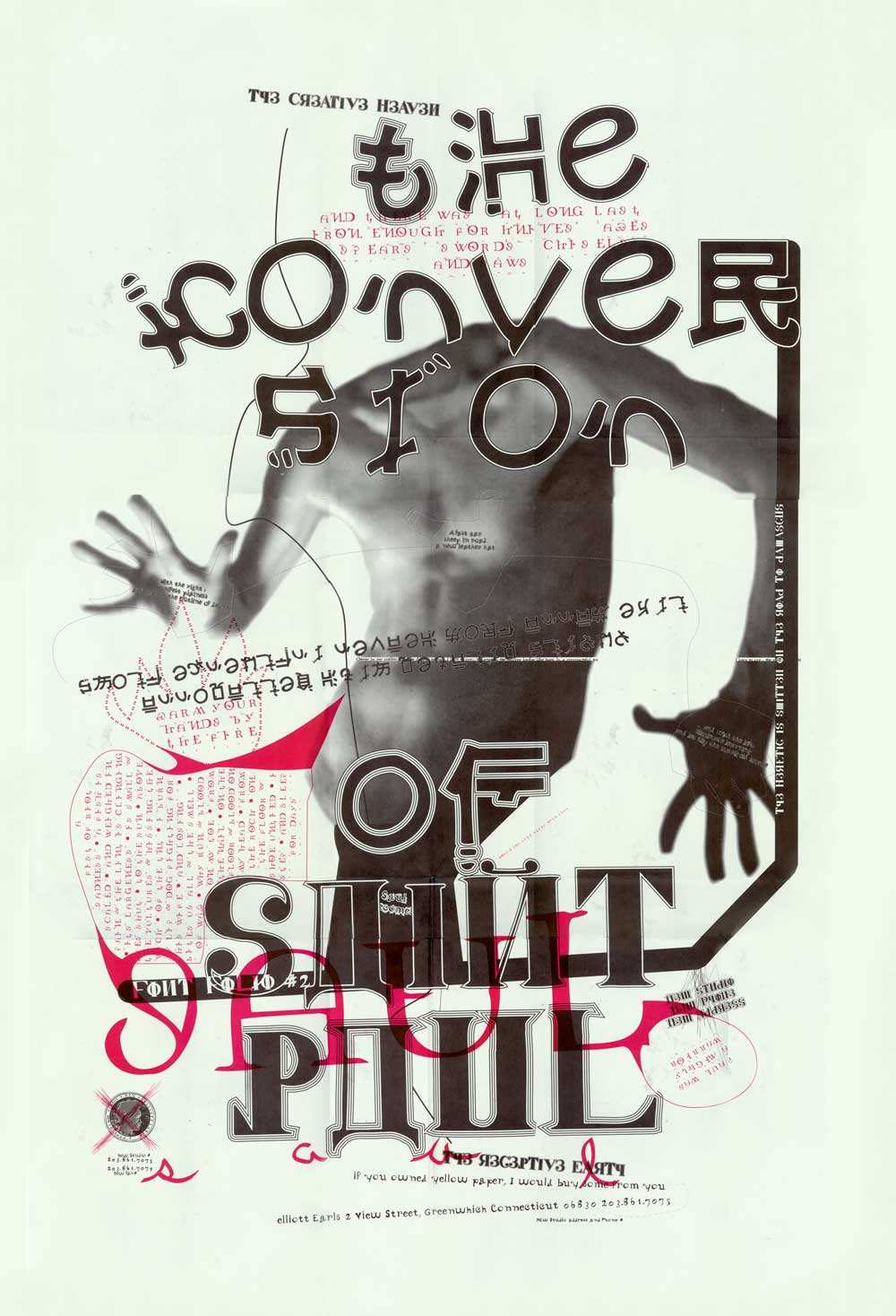
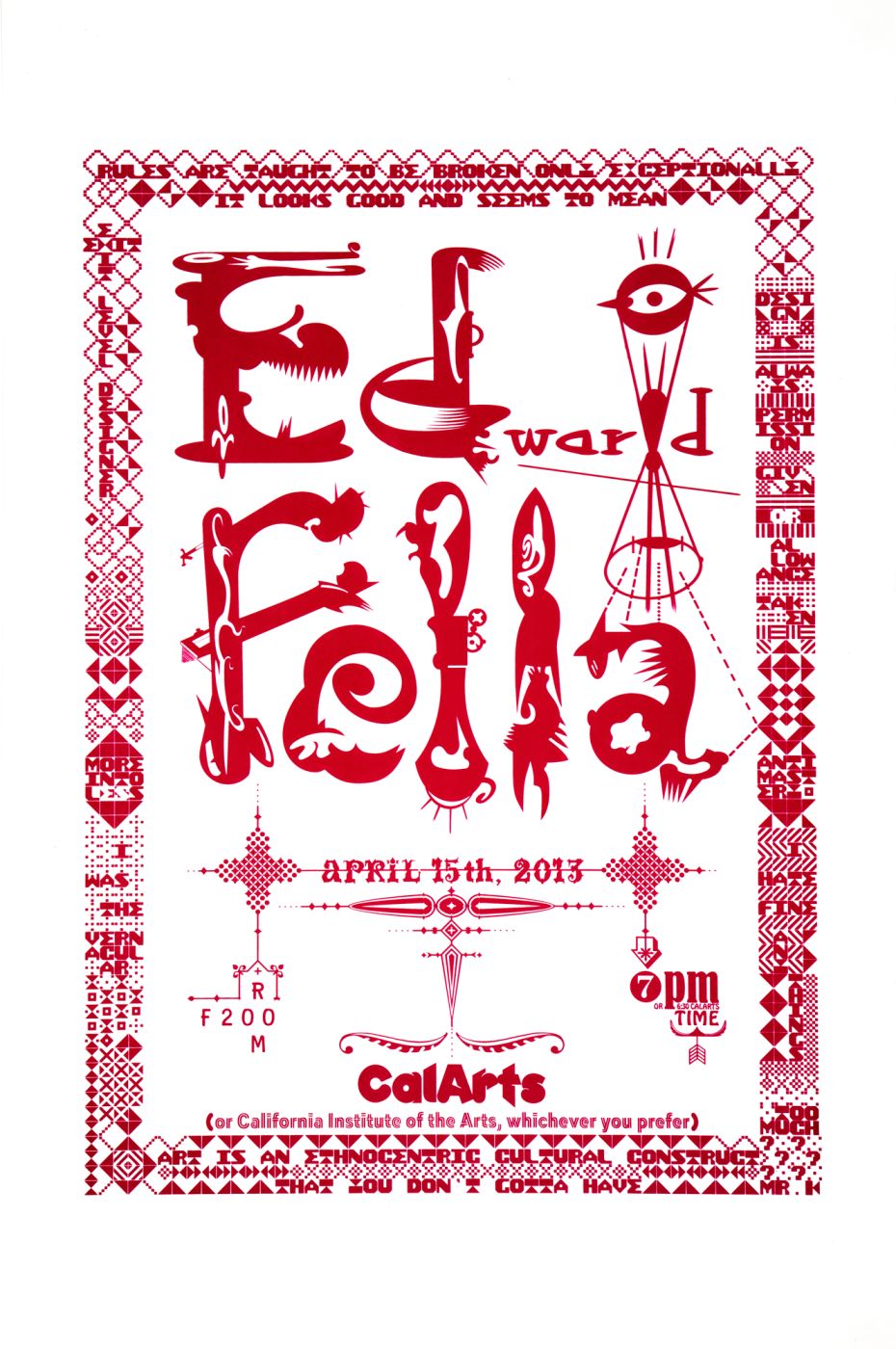




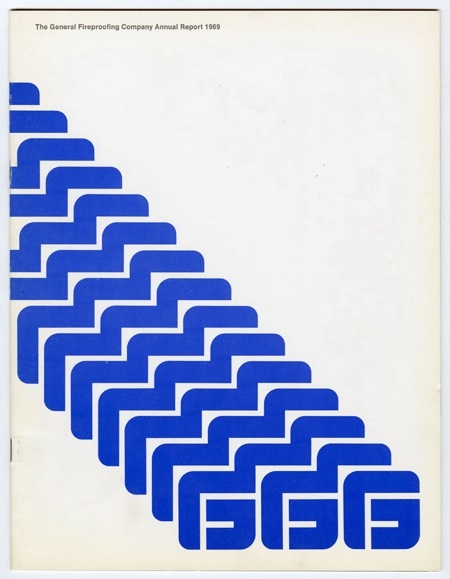









Objectives
Here’s the official description of the class:
A continuation of ARTS 190 with a focus on developing formal skills to express concepts and communicate messages using interactive, time-based, digital and traditional media.
The goal of this class is to start formalizing and focusing your interest and technical abilities as a designer of graphics.
My job, as I see it, is to do the following:
- ︎︎Impart technical skills︎
Show you different techniques and programs to design graphics, based on what is currently available (Adobe Creative Cloud, laser and inkjet printing).
- ︎︎Provide an aesthetic framework for your design practice︎The aforementioned skills tie into principles that are not linked to specific software or printing technology; they are perennial. It is important to acknowledge that these aesthetic principles and the technology that houses them are separate.
- ︎︎Provide a conceptual framework for your design practice ︎
Designs are usually for someone; a museum, a friend, yourself, “everyone.” They usually have a goal; to convince someone to buy something, to make someone fall in love, to annoy someone, to do nothing at all. This often leads to concepts that may not be graphics or design at all like ethics, the art in the aforementioned museum, or what love means.
- ︎︎Give historical context for your design practice︎
To be clear, this is not a history class, and this history will not be linear.
I’ll provide historical context for the different projects that we do as inspiration and so that you know what has come before.
- Help you find and develop your voice︎As your work develops I will help you explore what is uniquely you about your work.
- Do the work ︎ This is pretty much what it is, there are assignments and you have to do ‘em. As much as you can learn with your brain, you have to give your body the time to really internalize that knowledge; you have to practice. Your first idea will often not always be your best, just start.
- Participate & Communicate ︎ Graphic design is not simply about designing graphics. Dealing with and winning clients, pitching work, helping colleagues, and simply showing up on time are all part of the practice of being a graphic designer. To that end, your work does not exist in a vacuum or speak for itself; you have to justify your decisions, appreciate, challenge and question your peers as well as me. If you feel uncomfortable talking, please figure out a way to communicate: email, text, etc.
- Have a good attitude ︎ Let’s be very clear, I don’t mean anything like “smile more” here, and similarly everyone has bad days. That being said, don’t take your mood out on anyone else in the class, and don’t take negative critiques personally; they are in service of your growth as an artist and designer.
- Be real
︎ This ties in with all the other components above, if you have something going on personally, I’m happy to talk about it wherever and it whatever way is comfortable. I can’t guarantee that I can help, but for example I don’t want to single you out about getting off your phone or participating in class if you have something heavy going on in your personal life. Similarly, we should be able to be kind but realistic with our peers in critique and be able to help them grow and not personally attack them, but be kind and forgiving if we offend each other.
Required Materials
- Sketchbook/some repository for ideas & process documentation︎Work doesn’t come out of a vacuum. It requires concentrated effort over time, and letting bad ideas that make way for good ones. I think through drawing, so I keep a sketchbook. I like the small Muji ones that are passport sized and you can keep in your pocket at all times, but I’ve also used bigger spiralbound ones (they can always lay flat). Digitally I’d recommend Google Drive, Are.na, Tumblr, Pinterest, Dribbble. Make sure it is publically viewable.
![]()
![]()
![]()
- A digital repository for your work files and final output ︎This is slightly “selfish” but it just makes grading easier, it’s mainly so that everyone’s files aren’t all willy nilly accross emails. Additionally I may ask to look at your work files for some projects to make sure you are setting up layers not in a gross way. I also think it is good to get used to the idea of packaging files (when that matters) and keeping your folders organized for working with other people (even if the other person is yourself in 3 years). I’d recommend Google Drive or Dropbox. Do not send me random-ass links to stuff in emails unless it is to a folder in one of these sources. Both are very worth it if you can afford to pay for the non-free versions, or aren’t already.
-
Self-healing vinyl matte, good x-acto knife, & a good metal ruler
︎ Craft (the presentation of the physical manifestations) of your work is important. Most commercially available printers (i.e. the ones you will use for this class) will not print to the edge of a piece of paper. If you want your image to go, absolutely to the edge, then you’ll have to cut off the excess and cut it cleanly. These are absolutely necessary for that purpose. If you don’t have any philosophical issues with buying stuff from Amazon, it looks like these kinds of kits are pretty readily available for about $10 - $15. I’d recommend a ruler that is at least 12 to 18 inches long. I think it’s worth it to invest in a more “reputable” brand like Alvin, but if this is your option, nothin’ wrong.
![]()
![]()
![]()
- Computing device︎
It’s kind of economically unfair to assume everyone has a laptop, but I would strongly recommend getting your own personal computer if you can. Bother your sibling, pester your friend who just got a new one, mow everyone’s lawn, sell Beanie Babies....whateva. The work quality just seems to go up as you can work more independently and really put in the hours. I’ve worked with computers that are absolute ass and just learned to deal with it. If money is an issue you, you can just hunt for deals on TigerDirect (look for refurbished items). You can get a “usable” computer for around $200 (probably less) if you really look. I made this with a shitty refurbished Sony Vaio and a cracked version of CS6. I would recommend a laptop over a desktop computer, but maybe you’re good at building stuff or play a lot of games, idk. I can help steer you in the right direction if you have no idea what to look for. Generally you won’t need an especially powerful computer except for After Effects to make things go a bit faster/smoother.
- Adobe Creative Suite︎I’m not sure if people still pirate CC, or how one would even do that these days, but I currently pay for it. This is because I pirated it for a great many years (allegedly ︎) and I truly feel like I owe them something. There are alternatives that I see people recommending and looking at, but the reality is that Adobe is the industry-standard for these programs and they actually approach affordability now; as such they will be the basis for demonstrations in the class. You can probably social engineer Adobe into giving you a couple months for free.
- Access to typefaces︎System typefaces are totally fine at the end of the day. In fact, it took quite a bit of effort to get “pretty” typefaces onto home computers︎but this is the time to try some freaky shit and understand what you do and don’t like.
Engage with the future and history and typography and see how it feels when things are smushed together. Another reason to get Creative Cloud is that it gives you “free” access to Adobe Fonts, which has a great selection of stuff. Other resources are: - Me (I will share stuff with you, but if you use any of the typefaces for your own work, than please buy them afterwards)
- Futurefonts.xyz (mostly affordable, in-progress typefaces some of which have free demo versions)
- OH No Type Company(Some of these are available on Adobe Fonts and FutureFonts, but there is a pack of “demo” fonts here that you can download)
- Velvetyne.fr (Good free fonts, however they’re currently on strike ︎)
- Google Fonts(Free. Mostly “regular-ass stypefaces” but you can find some nice stuff if you look around)
- League of Movable Type (Free. Similar “regular-ass typefaces” but worth having)
- The Designer’s Foundry(There is some cute stuff here, but nothing free. This used to be called “Ten Dollar Fonts” the stuff here is pretty affordable)
Nice-to-have, but not necessarily needed materials
-
Your own printer ︎The printers/paper in this lab are not great, the photo lab and printing lab are not always open at the best times (relative to this class), you may want to work on something after the closest Staples closes, or use different paper stock.
- A “long” stapler ︎We’ll be making a couple booklets/zines in this class, and they are always an option to you for extra credit for the readings we do. The ones like the one on the left are better, the one on the left are typically easier to find. I’ll try to bring one to class when we have to have zines or booklets due, but please try to make this critique process go as smoothly as possible.
- Tablet ︎ You can certainly get by without one in this class, but if you draw, or think through drawing, these are a great tool.
![]()
![]()


Prerequisites
This class will build on the concepts and techniques
ARTS190 ︎Design Foundations, is meant to prepare you for
ARTS246 ︎Design 2, and assumes you are taking
ARTS242︎Typography 1. The reasoning behind this is that I want to really want to hunker down on the things we cover in this class, and related to that, I cannot cover the absolute basics of certain programs, like moving content, saving and opening files, and layering. That being said, not all the syllabi that I’ve seen are the same, so if you are having trouble or forgot something during a demonstration, I will attempt to keep everyone in the same place & I will probably ask if everyone is familiar with a given topic. Additionally, the demonstrations will have an accompanying screen capture of what we went over in class.
If you want to catch up for feel that you haven’t absorbed a work from a prior class, you should review Graphic Design: The New Basics by Ellen Lupton (it looks like the Design Foundations syllabi I’ve seen are beased on that). There’s also a website that provides some context for the book here.
Attendance
Here’s the official Queens College attendance policy (pg.4 of this document)By registering in a course, the student assumes the obligation to fulfill the requirements set for that course by its instructor. Although absence in and of itself shall not affect a student’s grade, students are responsible for such activities as participation in class discussions, laboratory sessions, field trips, etc.; the preparation of papers and reports; and the taking of quizzes and examinations, any or all of which may constitute a component in the final grade for the course. In addition to observing the regulation regarding withdrawal from a course, students are expected, as a normal courtesy, to inform the course instructor of any prolonged absence or withdrawal.
I am not obligated to fail you simply because you are absent, or have acrued a certain number of absences, which is a good thing. However, being in class and your subsequent participation is part of your grade. Between three absencences without any advanced warning is where you are in very clear danger of failing.
Be on time for class, arrive within 10 minutes of the class’s start time. Being on time means arriving a little bit before such that you’re ready to go at the class start time. This is most important for critique if we need to hang up work, or send files. I will send an advanced warning if I’m in danger of being late. Leaving class early without a valid reason (that means letting me know before class that you have to leave early) counts as being late. If you leave without explanation more than an hour before the class is done this will count as an absence. Two latenesses will count as half a grade reduction.
It sucks to have to repeat the same thing again, so if you’re late, I will not go back and re-teach any demos or concepts until after a demonstration or discussion is done. Please don’t disturb another student who was on time unless they are ahead and able to help you.
If you have a medical condition, job, or something going on personally that prevents you from getting to class on time, completing work, or being in class the entire duration please discuss it for me so I know.
Grading (the class)
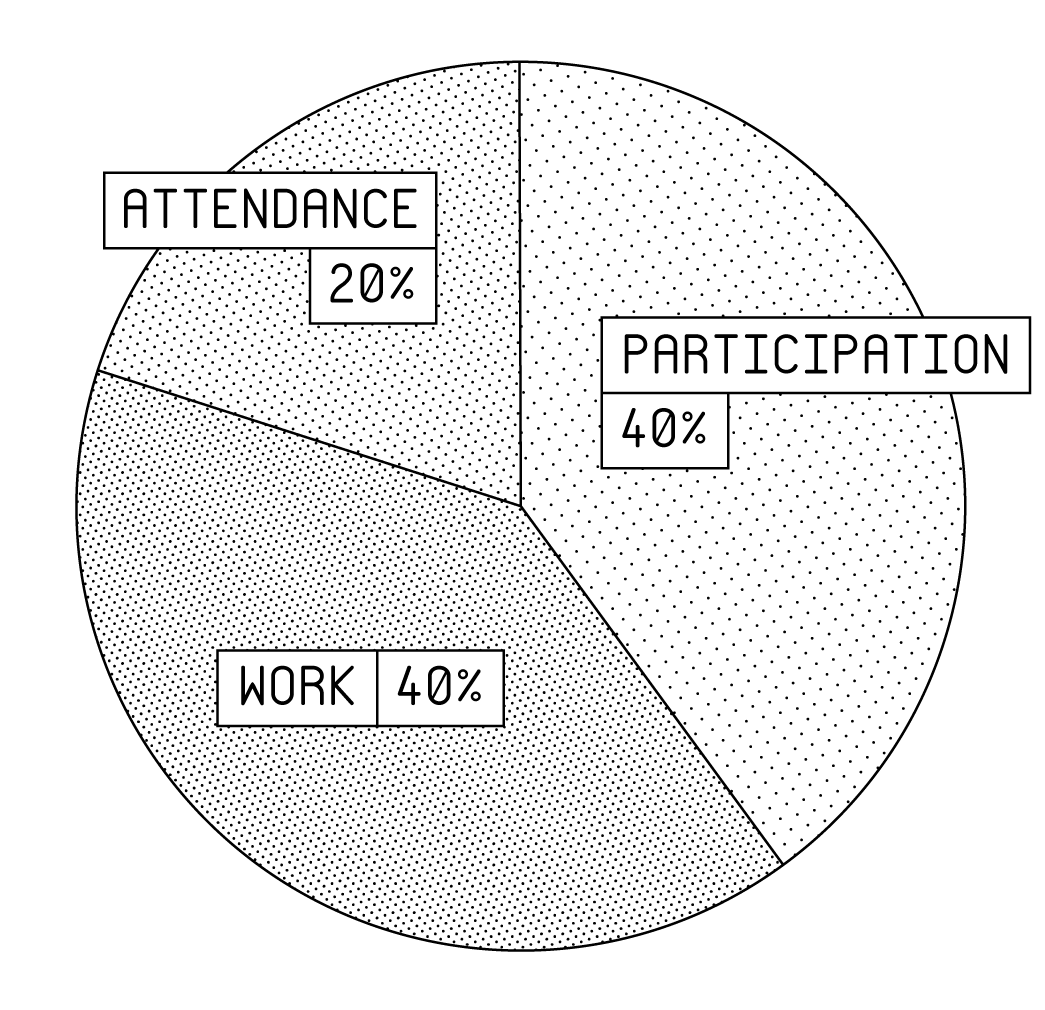
A
I have to tell you to stop participating in class discussions & your work consistently goes beyond the boundaries of the assignment (in a good way).
You are somewhat timid in class but your work possesses a certain je ne sais quoi, or your work is more advanced and you are forced into this class by some twist of fate.
B
Your work is well constructed and shows a noticable amount of effort and dedication, is submitted on time and you participate frequently in class. You were late to six classes without discussing with me at any point in the semester that you have a job, and your shift ends right before class.
Your work almost always shows an excellent level of effort and exploration, however you struggled significantly with between one and two projects.
C
You’ve shown up to class on time for every class, you’ve done the minimum requirements for every assignment, and you rarely participate in class discussions and critiques.
You communicate and participate in class discussion, but not to the degree where I’d have to tell you to stop to let other people join in. You submitted several of your assignments late but they showed promise and effort.
D & F
(If you are in danger of getting a D or an F,you will more than likely be notified in advance)
You did (almost) nothing during the semester, the work you did hand in was multiple weeks late, you have to be reminded (constantly) to get off your telephone.
Your work was extremely shoddily constructed and seems like you made it a couple minutes before class and you were absent for three weeks without letting me know.
Grading (assignments)
Assignments will be graded on the following criteria: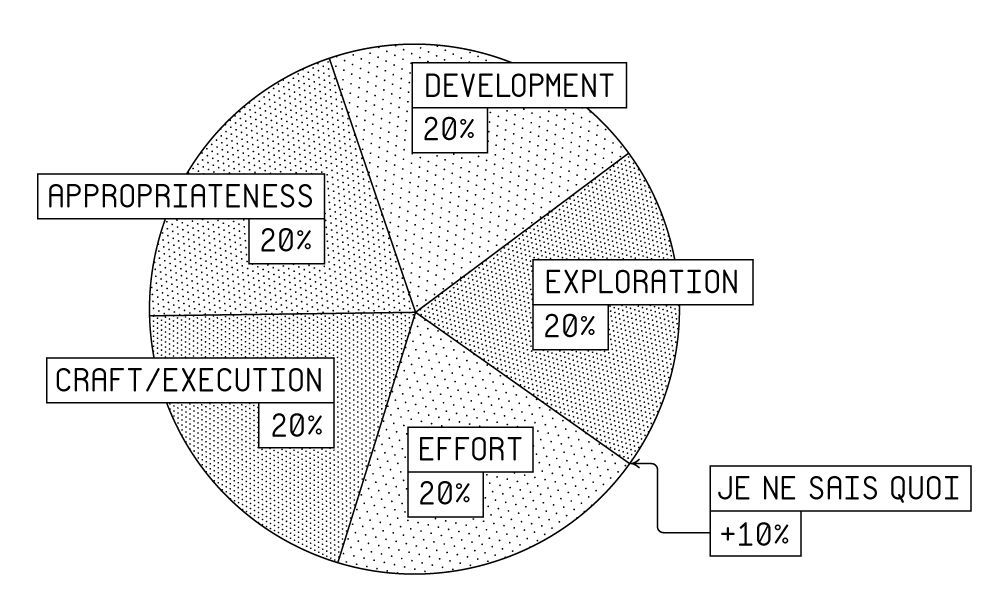
-
Appropriateness (20%) ︎Is the outcome related to the prompt? Did you follow whatever directions were involved and meet the minimum requirements?
- Craft/Execution
(20%)
︎ This encompasses both digital and “analog” craft. If you needed to trim something, is it trimmed cleanly? Is your print out all wrinkled and shit? If I examine your files, are the layers well organized?
- Effort
(20%)
︎ How many versions did you try? Did you simply go with your first idea? Did you attempt something outside of your comfort zone (which might take more time)?
- Exploration (20%) ︎ Did you attempt one or more of the challenges in the project sheet? Did you learn a new piece of software or technique not outlined in the project? Did you do extensive research about a topic related to your piece?
- Development
(20%)
︎ Does the project reflect an evolution in your personal development as a designer?
- je ne sais quoi (+10%) ︎ Je ne sais quoi is French for “I know not what.” Grading + subjectivity is hard, to that end, I’m adding an additional 10% for that. I will not grade you above 100% for an assignment but I will “bank” this factor for extra credit. This also includes the “no shuriken mode” challenges which will be part of all assignments.
All assignments are due on the date outlined in the project sheet or project web page. The following conditions constitute a late assignment:
-
You don’t have your project with you in any form.
-
Your project requires printing, and you did not print it out.
-
Your project requires a dongle or specific software and you didn’t check if the classroom had it at least 24 hours before class.
-
Your project required it be sent in some form (ie via email), in advance and you did not sent it.
- You had an extenuating circumstance preventing you from completing the assignment, however you did not communicate with me at least 24 hours prior to class or figure out an alternative method of delivery.
Late work is subject to the following conditions:
- Your work will not be critiqued.
- You may submit your assignment again any subsequent week, however you will lose an entire letter grade for your assignment each week.
The point here is not to be a hard-ass or something; all assignment due dates are (almost always) attached to a critique. Critique is super important to me, and valuable to your development as a designer (and human). A critique where everyone has their work, everyone talks about each other’s work, and everyone has put a suitable amount of effort into their work to help generate conversation is a good critique. Additionally, as we will get more into, being a graphic designer is not simply about being a designer of graphics. I totally understand the reality of doing things at the last minute, however handing things in on time, planning, and communicating with clients and colleagues effectively is part of your job. Often times being fun and easy to work with can make up for a lack of raw “talent.”Schedule Overview︎About MeI’m an designer, artist, and most recently an educator. My first class was a different version of this one last semester. I also teach at SUNY Purchase (ever so slightly upstate). I absolutely love teaching, so please help me to make the most out of it.I was most recently (as in...the evening before my first class here last semester) a Creative Director in animation. I directed stuff like this. I started at that studio animating stuff like this, and still freelance doing stuff like this. My personal practice is pretty interdisciplinary and looks like this: or like this: I was playing with DrawBot quite a bit last semester and over the break. I live in Ridgewood, Queens with my three cats Cumberbund (misspelling intentional), Titus, and Booger and my partner Hailey. 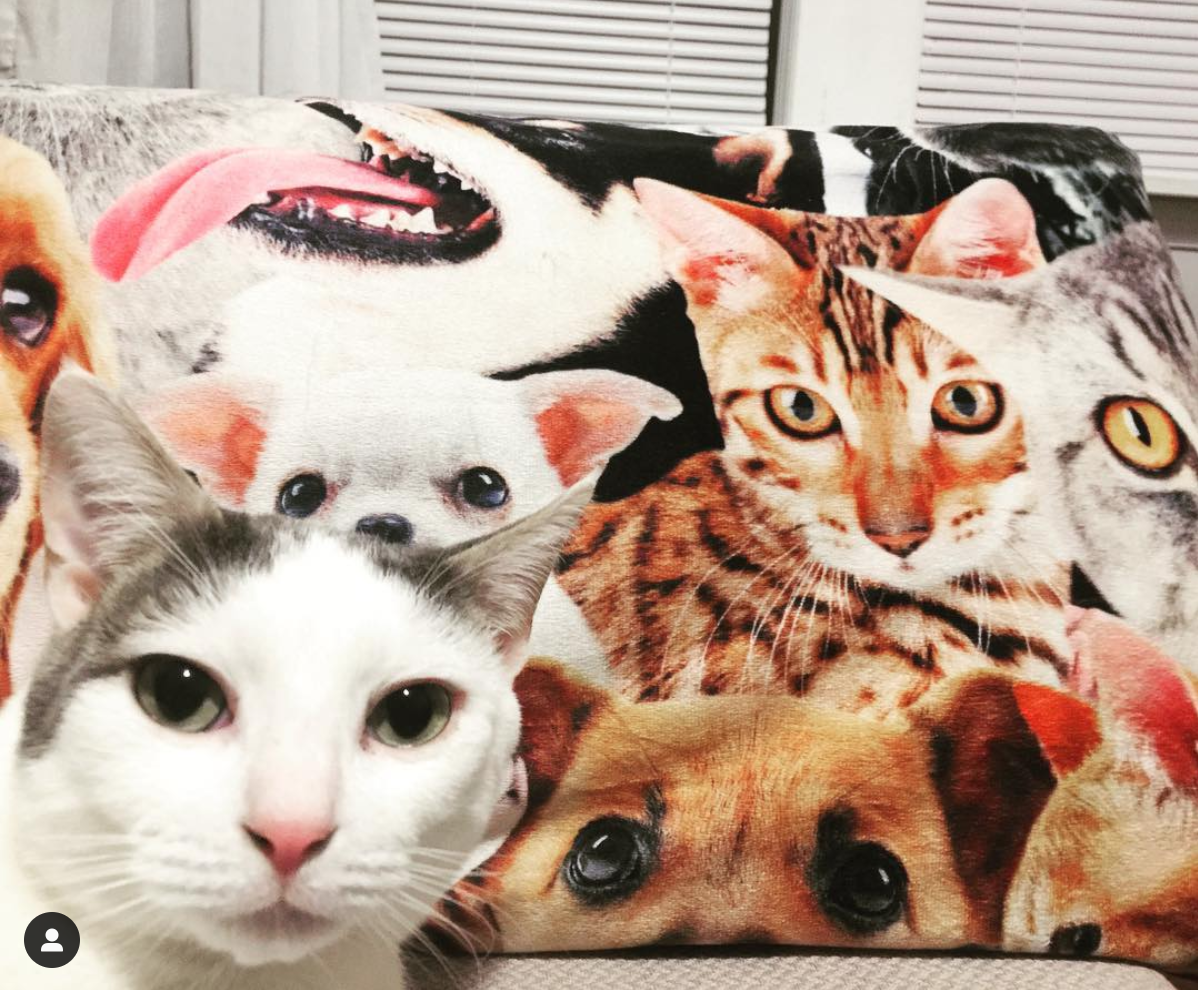 Let’s talk about y’all!
Class Discord︎This is mostly for instant messaging purposes. I like discord, but let me know if you prefer another service. This should never expire, let me know if you’re having trouble. You can message me privately for help or feedback or use the class discord so we can talk about stuff in a more public way, I’d love if the discord blew up but not trying to force anything ︎.First Project︎“Do It for Her” Poster︎ |
︎Back to Design 1








